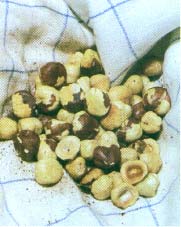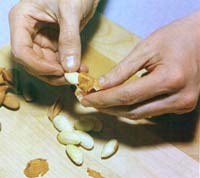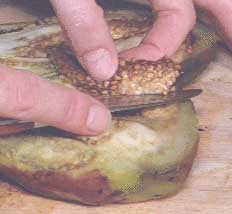

 |
Vernon |
More than one way to skin a nut
Having a well-stocked pantry means that you can turn out linzertorte or
almond cookies when the inspiration hits, without a special trip to the
market. Since many recipes for cakes and cookies call for skinned or
blanched nuts, it's helpful to know the best way to get rid of the papery,
slightly bitter outer skin that can interfere with the appearance and
texture of baked goods. Blanching, boiling, and roasting are the most
common methods for skinning nuts.
Rubbing roasted hazelnuts in a towel quickly loosens
their skins. Don't fret
about getting rid of every last bit of skin: some will always
stick. Blanching is often used to loosen the skins of almonds and
pistachios. Put the shelled nuts in a bowl, cover with boiling water, and
let them sit for a minute or two. Too much time in the water may soften
the nuts. Drain and let the nuts cool a bit. The skins should slip off
easily when you rub the nuts between two fingers. If the skins are
stubborn, blanch the nuts for another minute in boiling water.
Boiling. For 1Ž2 cup hazelnuts, add 2 tablespoons baking soda to
11Ž2 cups boiling water and boil the nuts. The alkaline baking soda
loosens the skins, and the water turns black. After three minutes, remove
a nut from the pan and run it under cold water. If the skin doesn't slip
off easily, boil the nuts for a few more minutes. When the skins are
loosened, rinse the nuts thoroughly under cold water.
Roasting is a good way to remove the skins of peanuts and
hazelnuts. Spread the nuts in a single layer on a baking sheet and roast
for 10 to 12 minutes at 350°F, shaking the pan occasionally to prevent
scorching. Pour a handful of the warm nuts into a heavy cotton towel and
rub them between layers of the cloth to remove the skins. Roasting, Peeling, and Seeding Eggplant Smoky roasted eggplant is a delicious addition to many dishes, but preparing it can be a messy chore if not undertaken with a systematic approach and a sharp paring knife. The best heat source for roasting eggplant is an outdoor grill fueled
by a fragrant wood, but a regular gas range will do the trick nicely, as
well. A third, but less satisfactory, method is to use your broiler;
position the eggplant as close to the heat as possible. If you're using a
gas stove, line the burners first with aluminum foil. The goal when roasting eggplant is to preserve as much as possible of
the natural shape of the eggplant because it will be much easier to peel
and seed if its structure is intact. Place the eggplant directly on the
burner with the flame set to low and leave it to char. Carefully turn it
by the stem to char the entire surface. Make sure the eggplant is
thoroughly blackened on all sides, but don't cook it so long that it loses
its shape and becomes mushy. Set it aside to cool completely.
To peel off the skin, put the eggplant on a cutting board, pinch a
piece of skin, and pull down lengthwise with the grain, being careful not
to tear the flesh, which can make seed removal more difficult. Any small
specks of charred skin may be blotted away with a dry paper towel or
simply left to blend in with the flesh.
To remove the seeds, trim off the stem and insert a sharp paring knife
halfway through the eggplant. Make an incision that runs down the length
of the eggplant. Gently fold back the eggplant halves so it opens like a
book. You will see clusters of seeds running lengthwise. With your
fingertips, lightly stroke down the seed lines to separate them from the
flesh. Insert the tip of your paring knife at about a 20° angle just under
the seeds and slice along one side to separate the seeds from the flesh.
Slice down the other side of the seed cluster to release it entirely.
Finally, appraise your work. A few scattered seeds will do no harm, but
too many--particularly mature ones that are hard and bitter--will detract
from the sweet silkiness of good roasted eggplant.

To
rid almonds of their tenacious skin, blanch them quickly.
After a one- or two-minute soak, the skins should peel
off easily.

It's nearly
impossible to remove every speck of skin, so don't fret over small bits
that won't come off. You can also use this method for pistachios, but
roasting almonds only seems to make the skins more tenacious.

Lift the eggplant's seed cluster and slice it from the flesh. A gentle touch will keep the cluster intact for easier
removal.